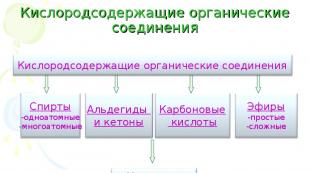When heated, water expands or contracts. When water freezes, it expands or contracts: simple physics. Water needs more space when it cools
Japanese physicist Masakazu Matsumoto has put forward a theory that explains why water contracts instead of expanding when heated from 0 to 4°C. According to his model, water contains microformations - “vitrites”, which are convex hollow polyhedra, the vertices of which contain water molecules, and the edges are hydrogen bonds. As the temperature rises, two phenomena compete with each other: the elongation of hydrogen bonds between water molecules and the deformation of vitrites, leading to a decrease in their cavities. In the temperature range from 0 to 3.98°C, the latter phenomenon dominates the effect of elongation of hydrogen bonds, which ultimately gives the observed compression of water. There is no experimental confirmation of Matsumoto’s model yet, as well as other theories explaining the compression of water.
Unlike the vast majority of substances, water can reduce its volume when heated (Fig. 1), that is, it has a negative coefficient of thermal expansion. However, we are not talking about the entire temperature range where water exists in a liquid state, but only about a narrow section - from 0°C to approximately 4°C. With b O At higher temperatures, water, like other substances, expands.
By the way, water is not the only substance that has the property of contracting when temperature increases (or expanding when cooling). Bismuth, gallium, silicon and antimony can also boast of similar behavior. However, due to its more complex internal structure, as well as its prevalence and importance in various processes, it is water that attracts the attention of scientists (see The study of the structure of water continues, “Elements”, 10/09/2006).
Some time ago, the generally accepted theory answering the question of why water increases its volume as the temperature decreases (Fig. 1) was the model of a mixture of two components - “normal” and “ice-like”. This theory was first proposed in the 19th century by Harold Whiting and was later developed and improved by many scientists. Relatively recently, within the framework of the discovered polymorphism of water, Wieting’s theory was rethought. It is now believed that there are two types of ice-like nanodomains in supercooled water: high-density and low-density amorphous ice-like regions. Heating supercooled water leads to the melting of these nanostructures and the appearance of two types of water: with higher and lower density. The cunning temperature competition between the two “grades” of the resulting water gives rise to a non-monotonic dependence of density on temperature. However, this theory has not yet been confirmed experimentally.
You need to be careful with this explanation. It is no coincidence that we are talking here only about structures that resemble amorphous ice. The fact is that nanoscopic regions of amorphous ice and its macroscopic analogues have different physical parameters.
Japanese physicist Masakazu Matsumoto decided to find an explanation for the effect discussed here “from scratch,” discarding the theory of a two-component mixture. Using computer simulations, he examined the physical properties of water over a wide temperature range - from 200 to 360 K at zero pressure - to understand on a molecular scale the true reasons for the expansion of water when it cools. His article in the magazine Physical Review Letters it's called: Why Does Water Expand When It Cools? (“Why does water expand when it cools?”).
Initially, the author of the article asked the question: what affects the coefficient of thermal expansion of water? Matsumoto believes that for this it is enough to find out the influence of only three factors: 1) changes in the length of hydrogen bonds between water molecules, 2) topological index - the number of bonds per water molecule, and 3) deviation of the angle between bonds from the equilibrium value (angular distortion).

Before we talk about the results obtained by the Japanese physicist, we will make important comments and clarifications regarding the above three factors. First of all, the usual chemical formula of water, H 2 O, corresponds only to its vapor state. In liquid form, water molecules are combined into groups (H 2 O) through hydrogen bonding. x, Where x- number of molecules. The most energetically favorable combination of five water molecules ( x= 5) with four hydrogen bonds, in which the bonds form equilibrium, so-called tetrahedral angle, equal to 109.47 degrees (see Fig. 2).
Having analyzed the dependence of the length of the hydrogen bond between water molecules on temperature, Matsumoto came to the expected conclusion: an increase in temperature gives rise to a linear elongation of hydrogen bonds. And this, in turn, leads to an increase in the volume of water, that is, to its expansion. This fact contradicts the observed results, so he further examined the influence of the second factor. How does the coefficient of thermal expansion depend on the topological index?
Computer modeling gave the following result. At low temperatures, the largest volume of water in percentage terms is occupied by water clusters, which have 4 hydrogen bonds per molecule (topological index is 4). An increase in temperature causes a decrease in the number of associates with index 4, but at the same time the number of clusters with indices 3 and 5 begins to increase. Having carried out numerical calculations, Matsumoto discovered that the local volume of clusters with topological index 4 practically does not change with increasing temperature, and the change in the total volume of associates with indices 3 and 5 at any temperature mutually compensate each other. Consequently, a change in temperature does not change the total volume of water, and therefore the topological index does not have any effect on the compression of water when it is heated.
It remains to be clarified the effect of angular distortion of hydrogen bonds. And this is where the most interesting and important begins. As mentioned above, water molecules tend to unite so that the angle between the hydrogen bonds is tetrahedral. However, thermal vibrations of water molecules and interactions with other molecules not included in the cluster prevent them from doing this, deviating the hydrogen bond angle from the equilibrium value of 109.47 degrees. To somehow quantitatively characterize this process of angular deformation, Matsumoto and colleagues, building on their previous work Topological building blocks of hydrogen bond networks in water, published in 2007 in Journal of Chemical Physics, hypothesized the existence of three-dimensional microstructures in water that resemble convex hollow polyhedra. Later, in subsequent publications, they called such microstructures showcases(Fig. 3). In them, the vertices are water molecules, the role of edges is played by hydrogen bonds, and the angle between hydrogen bonds is the angle between the edges in vitrite.
According to Matsumoto's theory, there is a huge variety of forms of vitritis, which, like mosaic elements, make up the majority of the structure of water and which at the same time evenly fill its entire volume.

Water molecules tend to create tetrahedral angles in vitrites, since vitrites must have the lowest possible energy. However, due to thermal motions and local interactions with other vitrites, some microstructures do not exhibit geometries with tetrahedral angles (or angles close to this value). They accept such structurally nonequilibrium configurations (which are not the most favorable for them from an energetic point of view), which allow the entire “family” of vitrites as a whole to obtain the lowest energy value among possible ones. Such vitritis, that is, vitritis that seem to sacrifice themselves to “common energy interests,” are called frustrated. If in unfrustrated vitritis the volume of the cavity is maximum at a given temperature, then frustrated vitritis, on the contrary, have the minimum possible volume.
Computer simulations conducted by Matsumoto showed that the average volume of vitrite cavities decreases linearly with increasing temperature. In this case, frustrated vitritis significantly reduces its volume, while the volume of the cavity of unfrustrated vitritis remains almost unchanged.
So, the compression of water with increasing temperature is caused by two competing effects - the elongation of hydrogen bonds, which leads to an increase in the volume of water, and a decrease in the volume of the cavities of frustrated vitrites. In the temperature range from 0 to 4°C, the last phenomenon, as calculations have shown, prevails, which ultimately leads to the observed compression of water with increasing temperature.
It remains to wait for experimental confirmation of the existence of vitrites and their behavior. But this, alas, is a very difficult task.
One of the most common substances on Earth: water. It, like air, is necessary for us, but sometimes we don’t notice it at all. She just is. But it turns out
One of the most common substances on Earth: water. It, like air, is necessary for us, but sometimes we don’t notice it at all. She just is. But it turns out that ordinary water can change its volume and weigh either more or less. When water evaporates, heats and cools, truly amazing things happen, which we will learn about today.
Muriel Mandell, in her entertaining book “Phycisc Experiments for Children,” presents interesting thoughts about the properties of water, on the basis of which not only young physicists can learn a lot of new things, but also adults will refresh their knowledge, which has not had to be used for a long time, so it turned out to be slightly forgotten.Today we will talk about the volume and weight of water. It turns out that the same volume of water does not always weigh the same. And if you pour water into a glass and it does not spill over the edge, this does not mean that it will fit in it under any circumstances.
1. When water is heated, it expands in volume
Place the jar filled with water in a pan filled with about five centimeters of boiling water. water and maintain a simmer over low heat. The water from the jar will begin to overflow. This happens because when water heats up, like other liquids, it begins to take up more space. The molecules repel each other with greater intensity and this leads to an increase in the volume of water.2. When water cools, it contracts
Allow the water in the jar to cool at room temperature, or add new water and place it in the refrigerator. After a while, you will discover that the previously full jar is no longer full. When cooled to 3.89 degrees Celsius, water decreases in volume as the temperature decreases. The reason for this was a decrease in the speed of movement of molecules and their approach to each other under the influence of cooling.It would seem that everything is very simple: the colder the water, the less volume it occupies, but...
3. ...the volume of water increases again when it freezes
Fill the jar with water to the brim and cover with a piece of cardboard. Place it in the freezer and wait until it freezes. You will find that the cardboard “lid” has been pushed out. At temperatures between 3.89 and 0 degrees Celsius, that is, when approaching its freezing point, water begins to expand again. It is one of the few known substances with this property.If you use a tight lid, the ice will simply smash the jar. Have you ever heard that even water pipes can be broken by ice?4. Ice is lighter than water
Place a couple of ice cubes in a glass of water. Ice will float on the surface. When water freezes, it increases in volume. And, as a result, ice is lighter than water: its volume is about 91% of the corresponding volume of water.This property of water exists in nature for a reason. It has a very specific purpose. They say that in winter the rivers freeze. But in reality this is not entirely true. Usually only a small top layer freezes. This ice sheet does not sink because it is lighter than liquid water. It slows down the freezing of water at the depth of the river and serves as a kind of blanket, protecting fish and other river and lake life from severe winter frosts. Studying physics, you begin to understand that a lot of things in nature are arranged expediently.
5. Tap water contains minerals
Pour 5 tablespoons of regular tap water into a small glass bowl. When the water evaporates, a white border will remain on the bowl. This rim is formed by minerals that were dissolved in the water as it passed through the layers of soil.Look inside your kettle and you will see mineral deposits. The same coating forms on the drainage hole in the bathtub.Try evaporating rainwater to test for yourself whether it contains minerals. Water has amazing properties that greatly distinguish it from other liquids. But this is good, otherwise, if water had “ordinary” properties, planet Earth would be completely different.The vast majority of substances tend to expand when heated. Which is quite easy to explain from the perspective of the mechanical theory of heat. According to it, when heated, the atoms and molecules of a substance begin to move faster. In solids, atomic vibrations reach greater amplitudes and require more free space. As a result, the body expands.
The same process occurs with liquids and gases. That is, due to an increase in temperature, the speed of thermal movement of free molecules increases, and the body expands. When cooling, accordingly, the body contracts. This is typical for almost all substances. Except for water.
When cooled in the range from 0 to 4°C, water expands. And it shrinks when heated. When the water temperature reaches 4°C, at this moment the water has a maximum density, which is equal to 1000 kg/m3. If the temperature is below or above this mark, then the density is always slightly less.
Thanks to this property, when the air temperature drops in autumn and winter, an interesting process occurs in deep reservoirs. When the water cools, it sinks lower to the bottom, but only until its temperature reaches +4°C. It is for this reason that in large bodies of water, colder water is closer to the surface, and warmer water sinks to the bottom. So when the surface of the water freezes in winter, the deeper layers continue to maintain a temperature of 4°C. Thanks to this moment, the fish can safely winter in the depths of ice-covered reservoirs.
Impact of water expansion on climate
The exceptional properties of water when heated seriously influence the Earth's climate, since about 79% of the surface of our planet is covered with water. Due to the sun's rays, the upper layers are heated, which then sink lower, and cold layers appear in their place. Those, in turn, gradually heat up and sink closer to the bottom.Thus, the layers of water continuously change, resulting in uniform heating until the temperature corresponding to maximum density is reached. Then, as they heat up, the upper layers become less dense and no longer sink down, but remain at the top and simply gradually become warmer. Due to this process, huge layers of water are quite easily heated by the sun's rays.
We are surrounded by water, by itself, as part of other substances and bodies. It can be in solid, liquid or gaseous form, but water is always around us. Why does asphalt crack on the roads, why does a glass jar of water burst in the cold, why do windows fog up in the cold season, why does an airplane leave a white trail in the sky - we will look for answers to all these and other “whys” in this lesson. We will learn how the properties of water change when heated, cooled and frozen, how underground caves and bizarre figures in them are formed, how a thermometer works.
Topic: Inanimate nature
Lesson: Properties of liquid water
In its pure form, water has no taste, smell or color, but it almost never is like that, because it actively dissolves most substances in itself and combines with their particles. Water can also penetrate into various bodies (scientists have found water even in stones).
If you fill a glass with tap water, it will appear clean. But in fact, it is a solution of many substances, among which there are gases (oxygen, argon, nitrogen, carbon dioxide), various impurities contained in the air, dissolved salts from the soil, iron from water pipes, tiny undissolved dust particles, etc.

If you pipette drops of tap water onto clean glass and let it evaporate, barely visible spots will remain.

The water of rivers and streams, and most lakes contains various impurities, for example, dissolved salts. But there are few of them, because this water is fresh.

Water flows on the ground and underground, fills streams, lakes, rivers, seas and oceans, creating underground palaces.

Making its way through easily soluble substances, water penetrates deep underground, taking them with it, and through slits and cracks in rocks, forming underground caves, dripping from their roofs, creating bizarre sculptures. Billions of water droplets evaporate over hundreds of years, and substances dissolved in water (salts, limestones) settle on the cave arches, forming stone icicles called stalactites.

Similar formations on the floor of a cave are called stalagmites.

And when a stalactite and stalagmite grow together to form a stone column, it is called a stalagnate.

Observing ice drift on a river, we see water in a solid (ice and snow), liquid (flowing underneath) and gaseous state (tiny particles of water rising into the air, which are also called water vapor).

Water can be in all three states at the same time: there is always water vapor in the air and clouds, which consist of water droplets and ice crystals.

Water vapor is invisible, but it can be easily detected if you leave a glass of water chilled in the refrigerator for an hour in a warm room, droplets of water will immediately appear on the walls of the glass. Upon contact with the cold walls of the glass, the water vapor contained in the air is converted into water droplets and settles on the surface of the glass.

Rice. 11. Condensation on the walls of a cold glass ()
For the same reason, the inside of the window glass fogs up during the cold season. Cold air cannot contain as much water vapor as warm air, so some of it condenses - turns into water droplets.

The white trail behind a plane flying in the sky is also the result of water condensation.

If you bring a mirror to your lips and exhale, tiny droplets of water will remain on its surface, this proves that when breathing a person inhales water vapor with the air.
When water is heated, it “expands.” This can be proven by a simple experiment: a glass tube was lowered into a flask of water and the water level in it was measured; then the flask was lowered into a vessel with warm water and, after heating the water, the level in the tube was re-measured, which rose noticeably, since water increases in volume when heated.

Rice. 14. A flask with a tube, the number 1 and a line indicates the initial water level

Rice. 15. A flask with a tube, the number 2 and a line indicates the water level when heated
As water cools, it “compresses.” This can be proven by a similar experiment: in this case, a flask with a tube was lowered into a vessel with ice; after cooling, the water level in the tube decreased relative to the original mark, because the water decreased in volume.

Rice. 16. A flask with a tube, the number 3 and a line indicates the water level during cooling
This happens because water particles, molecules, move faster when heated, collide with each other, are repelled from the walls of the vessel, the distance between the molecules increases, and therefore the liquid occupies a larger volume. When water cools, the movement of its particles slows down, the distance between molecules decreases, and the liquid requires less volume.
Rice. 17. Water molecules at normal temperature
Rice. 18. Water molecules when heated
Rice. 19. Water molecules during cooling
Not only water, but also other liquids (alcohol, mercury, gasoline, kerosene) have such properties.
Knowledge of this property of liquids led to the invention of a thermometer (thermometer), which uses alcohol or mercury.

When water freezes, it expands. This can be proven if a container filled to the brim with water is loosely covered with a lid and placed in the freezer; after a while we will see that the formed ice will lift the lid, going beyond the container.
This property is taken into account when laying water pipes, which must be insulated so that when freezing, the ice formed from the water does not rupture the pipes.
In nature, freezing water can destroy mountains: if water accumulates in rock cracks in the fall, it freezes in winter, and under the pressure of ice, which occupies a larger volume than the water from which it was formed, rocks crack and collapse.
Water freezing in the cracks of roads leads to the destruction of asphalt pavement.
Long ridges resembling folds on tree trunks are wounds from wood ruptures under the pressure of tree sap freezing in it. Therefore, in cold winters you can hear the crackling of trees in a park or forest.
- Vakhrushev A.A., Danilov D.D. The world around us 3. M.: Ballas.
- Dmitrieva N.Ya., Kazakov A.N. The world around us 3. M.: Fedorov Publishing House.
- Pleshakov A.A. The world around us 3. M.: Education.
- Festival of Pedagogical Ideas ().
- Science and education ().
- Public class ().
- Make a short test (4 questions with three answer options) on the topic “Water around us.”
- Conduct a small experiment: place a glass of very cold water on a table in a warm room. Describe what will happen, explain why.
- *Draw the movement of water molecules in a heated, normal and cooled state. If necessary, write captions on your drawing.









